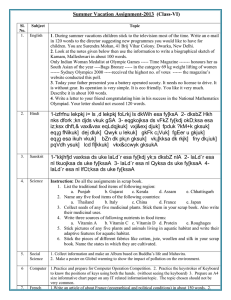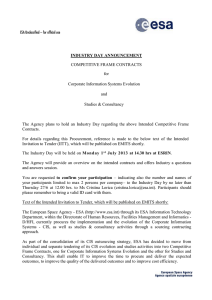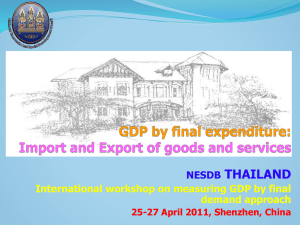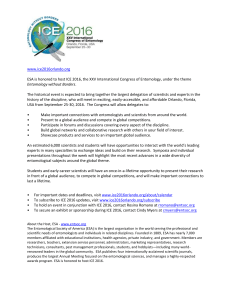ESA 1995 ESA 2010
advertisement
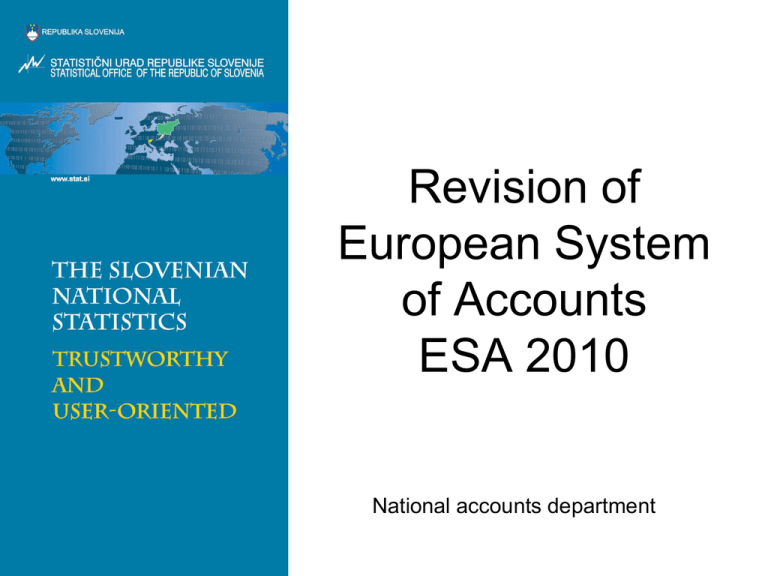
Revision of European System of Accounts ESA 2010 National accounts department European system of national and regional accounts • Regulation No. 549/2013 of the European Parliament and of the Council (ESA 2010). • Revised uniform sets of principles and methods for compiling economic accounts in EU Member States. • Compatible with the revised worldwide guidelines System of National Accounts to ensure international data comparability between countries. Revisions of European System of Accounts and System of National accounts ESA 1995 ESA 2010 compatible with compatible with SNA 1993 SNA 2008 ESA 2010 • Implementation in September 2014. • National accounts data series from 1995 onwards will be revised based on the new methodology. • ESA 2010 generates changes in 25 areas. • Most of the impact on the main aggregates of national accounts in Slovenia due to: - capitalisation of research and development expenditure, - capitalisation of weapon systems, - revised treatment of goods sent abroad for processing. Research and development expenditure • According to ESA 1995 R&D expenditure was recorded as intermediate consumption, the same approach is mostly applied in business accounting (current costs). • According to ESA 2010 this activity creates a new product – the results of R&D are fixed assets, for use in future production processes. Change in capitalisation of R&D expenditure: impact in case of market sector • In case of R&D activities for own use: additional output is measured and thus higher value added and GDP. Additional output is used as gross fixed capital formation. • In case of acquisition of external R&D services as final product: we move the expenditure from intermediate consumption to investment expenditure; lower intermediate consumption increases value added and GDP. Change in capitalisation of R&D expenditure: impact in case of non-market sector • R&D value added is estimated by the method of total cost, the same method is already applied for all non-market sector. • Therefore, from this perspective there is no change of value added, only a reclassification of output from final consumption of nonmarket sector to fixed capital formation. • However, there is an impact on increased value added and GDP due to increased consumption of fixed capital, which enters the calculation of value added, measured as consumption of new fixed assets i.e. past capitalised R&D. Expenditure of weapon system • Currently part of intermediate consumption, according to ESA 2010 fixed capital formation. • Impact of the change: - in the year of acqusition the intermediate consumption decreases and consequently also the government output, no change of value added and GDP; on the expenditure side of GDP this part of final consumption is reclassified as fixed capital formation, - in subsequent years the higher consumption of fixed capital increases value added and GDP. Goods for processing • Goods for processing sent abroad or received from abroad - without change of ownership. • ESA 1995 (SNA 1993) and BPM5 have introduced an exception in assigning the change of ownership at import and export of goods for processing (total value of goods) and import and export after processing (total value of goods and total value of processing service). - Goods for processing are recorded as export and import of goods. Goods for processing (contd.) • ESA 2010 (SNA 2008) and BPM6 do not allow the exception of assigning the change of ownership, only one transaction is recorded, the so called processing service: - Import of processing service: calculated as exports of goods for processing abroad (less) imports of goods for processing after processing; - Export of processing service: calculated as imports for processing to Slovenia (less) exports of goods after processing; - The value of the processing service is recorded as export and import of services. Goods for processing (contd.) • Discrepancy with the external trade statistics (IMTS), which still include the data on goods for processing in the same manner. • Values of import and export in national accounts and in balance of payment will be lower in recent years; export on average by 3%, import on average by 2.5%. • The change has no impact on the GDP and GNI level. Merchanting • Merchanting is defined as a purchase of goods by resident from non-resident and subsequent resale of the same goods to another non-resident; where the goods do not enter the economy of the merchant. • According to ESA and BPM6 merchanting is treated as follows: - Acquisition of goods from merchants is recorded as a negative export in the merchant economy; - Sale of goods is recorded as a positive export in the merchant economy; - Difference between purchase and sale, intended for resale is recorded as „net export for resale“. • The change has no impact on the GDP and GNI level. Impact of ESA 2010 revision Current estimate: • GDP increase by 1.5% to 2% in the whole period from 1995 onwards. - greater impact in recent years (closer to 2%) due to GDP decrease and relatively stable or increasing R&D expenditure. - for information: EU weighted average: GDP increase by approximately 2%. • The change will not have a significant impact on GDP growth rates, since the research and development expenditure and the consumption of fixed capital do not change much between the years. SKIS by ESA 2010 Standard classification of Institutional Sectors (SKIS) is based on ESA 2010 and the national regulation on SKIS (OJ RS No. 107/2013) includes more detailed breakdown of the government sector. Change of SKIS mainly concerns: • sub-sectors of financial corporations (the new classification is more detailed), • Holdings and Head offices (Holdings are classified to S.12, Head offices to S.11 or S.12), • greater importance is given to qualitative criteria, • quantitative measure of market/non-market status - the costs of capital are part of the production costs. SKIS by ESA 2010 (contd.) Changes and implementation agreed by SKIS Committee (members of Central bank, Ministry of finance, Agency for Public Legal Records and Related Services, SURS): • the bridge tables were prepared by central bank (for all S.12 units) and SURS (for non-financial holdings and head officies); identification by criteria of employment and assets in branch offices. The table was approved by the Committee, • the bridge table includes approx. 2000 business entities, • SKIS ESA 2010 was introduced in the Business Register on 1. 1. 2014 (in some data bases differently; from 2. 1. to 4. 1. 2014), • reporting obligations according to ESA 2010 SKIS concerns also past years. 2014 Publishing • Timetable for annual GDP remains the same. First publication according to ESA 2010 will be on 29. 8. 2014. All the data will be only according to ESA 2010, at that time the old data (published according to ESA 1995) will be removed. • The main national accounts aggregates will be published together with the quaterly sector accounts, on 30. 9. 2014 (according to new transmission programme; t+9 m, in current prices). • Data on gross fixed capital formation will be published at the level of 21 industries (according to transmission programme and because of new intelectual property data; previously they were published at the level of 64 industries). • The calendar of other data releases remains the same.


